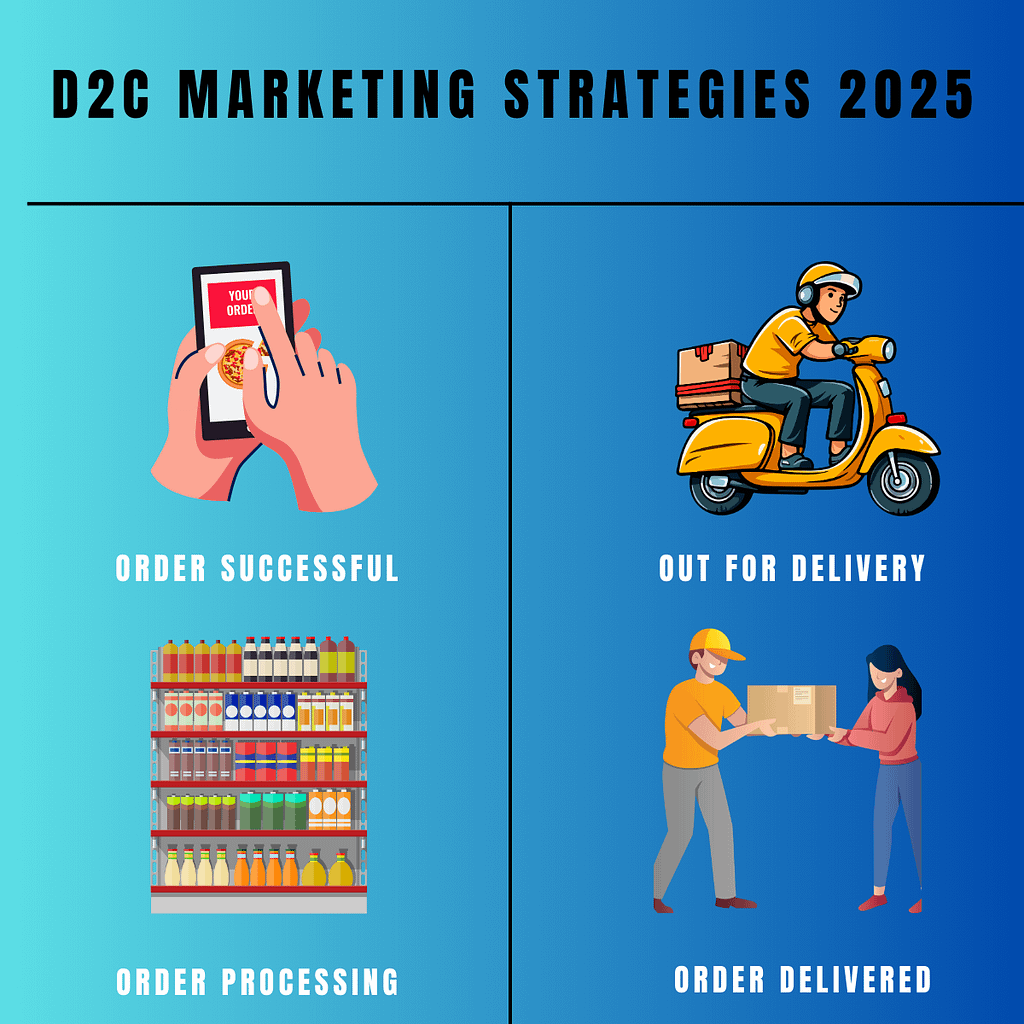The Direct-to-Consumer (D2C) landscape is undergoing a revolutionary transformation in 2025, creating unprecedented opportunities for innovative entrepreneurs. With the global D2C e-commerce market projected to reach between $175.4 billion and $230 billion this year, understanding the evolving consumer mindset, emerging technologies, and market dynamics has never been more crucial for success. This comprehensive guide unveils the hidden opportunities, deep customer insights, and strategic frameworks that will give your D2C venture a competitive edge in this thriving ecosystem.
The Evolving D2C Landscape in 2025
The Direct-to-Consumer model has fundamentally reshaped how brands interact with their customers, creating powerful opportunities for engagement, personalization, and sustainable growth. With a compound annual growth rate (CAGR) of 27.8%, the D2C sector continues to outpace traditional retail channels as businesses increasingly prioritize direct customer relationships. This shift represents a fundamental realignment of consumer expectations and business strategies rather than a temporary trend.
Recent data shows the D2C industry experiencing a remarkable 64% surge in festive orders, significantly outperforming traditional marketplaces and demonstrating the model’s growing consumer appeal. This success stems from multiple factors: rapid technological advancements, evolving consumer behaviors, and the pandemic’s lasting impact that accelerated digital adoption across all demographics. As entrepreneurs enter this dynamic space, understanding both current best practices and emerging trends will determine who thrives and who struggles.
For modern entrepreneurs, the D2C model offers compelling advantages over traditional retail approaches. By eliminating intermediaries, brands establish direct customer connections, gain valuable first-party data, maintain tighter control over messaging, and typically enjoy substantially higher profit margins. These benefits explain why everyone from established corporations to nimble startups and influential content creators are launching their own direct-to-consumer ventures.
Understanding Your D2C Customer in 2025
The foundation of any successful D2C venture begins with a deep understanding of your target audience’s evolving mindset, expectations, and behaviors. Today’s D2C consumers have developed sophisticated expectations, shaped by years of digital interactions and continuously elevated by innovations from market leaders.
The Video-First Consumer Mentality
Static product images and text descriptions no longer suffice in 2025’s competitive environment. According to research by eMarketer, nearly 80% of consumers now prefer purchasing from brands that offer comprehensive video content. This preference stems from a growing desire for interactive, dynamic shopping experiences that bridge the gap between convenient online shopping and engaging physical store interactions.
The concept of phygital commerce (physical + digital) has gained significant traction, enabling customers to interact with products in both virtual and physical spaces seamlessly. Video serves as the primary medium for delivering these experiences, allowing consumers to see products in action, understand features more comprehensively, and make purchasing decisions with greater confidence. D2C brands failing to incorporate robust video strategies appear outdated and unengaging to today’s visually-oriented consumers.
The Expectation of Hyper-Personalization
Today’s D2C consumers expect brands to understand their unique preferences, purchase history, and behavioral patterns to deliver truly personalized experiences. This expectation extends beyond basic product recommendations to include customized pricing models, tailored marketing communications, and individualized product configurations that meet specific needs.
Advanced AI and machine learning algorithms now enable brands to analyze consumer behavior with unprecedented precision, anticipating needs before customers even articulate them. For entrepreneurs launching D2C ventures in 2025, investing in robust data analytics isn’t optional—it’s essential for meeting fundamental customer expectations and building lasting relationships based on genuine understanding of individual preferences.
The Desire for Seamless, Unified Experiences
Today’s D2C customers expect consistent, frictionless experiences across all touchpoints—from social media interactions to website browsing, customer service engagements, and post-purchase support. The notion of separate, disconnected channels has given way to an expectation of unified communication where conversations flow naturally across platforms without losing context or requiring repetition.

This shift toward unified solutions that streamline communication across multiple platforms—voice, chat, email, and video—has become increasingly pronounced. Brands that invest in creating cohesive customer journeys that reduce friction at every stage of the buying process gain a substantial competitive advantage in an increasingly crowded marketplace.
Key Challenges Facing D2C Entrepreneurs in 2025
While the D2C model offers tremendous opportunities, entrepreneurs must navigate significant challenges unique to this business approach. Understanding these hurdles before launching can help new brands develop effective strategies to overcome them.
Standing Out in a Saturated Marketplace
As the D2C space continues its rapid growth trajectory, market saturation presents a formidable challenge for new entrants. With established players and constant new brand launches competing for consumer attention, genuine differentiation has become increasingly difficult. Simply offering a quality product no longer suffices; successful D2C brands must develop unique value propositions, distinctive brand identities, and innovative approaches to customer engagement.
This challenge is compounded by steadily rising customer acquisition costs across digital channels. As more brands compete for limited advertising inventory on social platforms and search engines, the cost of acquiring new customers continues to escalate. For entrepreneurs launching D2C ventures in 2025, developing cost-effective acquisition strategies and emphasizing customer retention will be critical components of a sustainable business model.
Managing Technology Integration and Complexity
The technological infrastructure required to support a competitive D2C operation in 2025 has grown increasingly sophisticated. Entrepreneurs must navigate a complex ecosystem of e-commerce platforms, customer relationship management systems, marketing automation tools, and data analytics solutions. Integrating these technologies into a cohesive stack that delivers seamless experiences requires significant expertise and strategic investment.
The rise of AI and automation offers powerful capabilities but adds another layer of complexity. While these technologies can dramatically enhance operational efficiency and customer experiences, implementing them effectively requires specialized knowledge or strategic partnerships. For resource-constrained startups, determining which technologies to prioritize and how to implement them cost-effectively represents a significant challenge.
Balancing Rapid Growth with Customer Experience Excellence
As D2C brands scale, maintaining the personalized, high-touch customer experience that often differentiates them from traditional retailers becomes increasingly difficult. Systems and processes that work effectively at smaller scales may break down as volume increases, leading to fulfillment delays, customer service issues, and inconsistent experiences across customer segments.

The challenge of scaling without compromising on customer experience is particularly acute for D2C brands, as their direct relationship with consumers represents both their greatest strength and their greatest vulnerability. A single negative interaction can damage brand perception in ways that are difficult to repair, especially for younger brands still establishing their market reputation and credibility.
Strategic Framework for Launching Your D2C Brand
With a clear understanding of the market landscape, customer expectations, and potential challenges, entrepreneurs can approach D2C brand development with a structured framework designed specifically for 2025’s unique environment.
Identifying Viable Niches and Untapped Opportunities
The foundation of any successful D2C venture begins with identifying a viable market opportunity. In 2025’s competitive landscape, this requires looking beyond obvious product categories to discover underserved niches or innovative approaches to established markets. Successful entrepreneurs conduct thorough market research, analyzing competitor offerings, customer pain points, and emerging trends to identify gaps they can uniquely fill.
This research should extend beyond traditional market analysis to include social listening, search trend analysis, and direct customer interviews. Understanding what potential customers are actively searching for provides invaluable insights into unmet needs and desires. Tools like Google Trends, social media analytics platforms, and SEO research tools can reveal patterns in consumer interests that may not be apparent through conventional market research methods.
With the D2C market projected to reach $230 billion by 2025, even small niches can represent significant opportunities. Entrepreneurs should look for segments where larger competitors are underperforming or ignoring customer needs, creating openings for more agile, focused brands that can deliver superior experiences to specific customer segments.
Developing a Distinctive Brand Identity
In the crowded D2C marketplace, a strong, distinctive brand identity serves as a crucial differentiator that helps you stand out and connect emotionally with your target audience. Effective branding goes beyond visual elements like logos and color schemes to encompass a brand’s story, values, voice, and position in customers’ lives. For 2025 consumers increasingly concerned with sustainability and social responsibility, brands that authentically embody meaningful values will resonate more deeply.
Developing this identity requires entrepreneurs to define their brand’s purpose—the fundamental reason it exists beyond profit generation. This purpose should address specific customer needs or aspirations while reflecting the brand’s unique perspective or approach. When clearly articulated and consistently expressed across all touchpoints, this purpose-driven identity creates emotional connections with customers that transcend transactional relationships.

Visual identity elements should be designed with digital-first considerations, ensuring they remain distinctive and recognizable across various platforms and formats. This includes optimization for video content, which will be increasingly dominant in D2C marketing by 2025. The most compelling brand identities maintain consistency while adapting appropriately to different contexts and communication channels.
Building a Technology Stack for Scalable Growth
The technical infrastructure supporting a D2C operation significantly impacts its ability to deliver exceptional customer experiences while scaling efficiently. In 2025, this infrastructure must support advanced personalization, seamless omnichannel experiences, and data-driven decision-making across all business functions.
At minimum, a competitive D2C technology stack includes:
- A robust, flexible e-commerce platform that supports customization, integrations with other systems, and excellent mobile experiences that meet consumers where they are.
- Customer relationship management (CRM) systems that centralize customer data and enable personalized communications across channels throughout the customer lifecycle.
- Analytics tools that provide actionable insights into customer behavior, marketing performance, and operational efficiency to inform strategic decisions.
- AI-powered solutions for personalization, customer service automation, and predictive analytics that anticipate consumer needs and behaviors.
- Video commerce capabilities that allow for interactive product demonstrations and immersive shopping experiences that convert browsing into sales.
The integration of these systems is as important as the individual components themselves. APIs and middleware solutions that facilitate seamless data flow between platforms will be essential for creating unified customer experiences and deriving maximum value from technology investments in this interconnected ecosystem.
Leveraging 2025’s Key D2C Marketing Strategies
Marketing approaches for D2C brands continue to evolve rapidly, with strategies that were cutting-edge just a few years ago now considered table stakes. Entrepreneurs launching D2C ventures in 2025 should focus on these emerging approaches that align with current consumer expectations.
Video-First Content Strategy
With nearly 80% of consumers preferring to buy from brands that offer video content, developing a comprehensive video strategy has become essential for D2C success. This extends beyond traditional product videos to include interactive demonstrations, behind-the-scenes content, customer testimonials, and educational material that addresses common questions or demonstrates various use cases.
Live streaming commerce represents a particularly powerful opportunity, combining immediate engagement with direct selling capabilities. These real-time interactions allow brands to answer questions, demonstrate products in action, and create urgency through limited-time offers. For entrepreneurs with limited resources, even smartphone-captured authentic content can perform well when it delivers genuine value and aligns consistently with brand identity.
The rise of short-form video platforms continues to create new opportunities for D2C brands to reach potential customers with engaging, visually-driven content. These formats require different approaches than traditional marketing videos, emphasizing quick hooks, visual impact, and emotional resonance over detailed information that can be provided at later stages of the customer journey.
AI-Powered Personalization at Scale
Artificial intelligence has transformed personalization from a manual, resource-intensive process to an automated system capable of delivering individualized experiences to millions of customers simultaneously. By 2025, these capabilities will have advanced significantly, enabling even smaller D2C brands to implement sophisticated personalization strategies that previously were available only to enterprise-level organizations.
AI-driven recommendation engines can analyze browsing behavior, purchase history, and similar customer profiles to suggest relevant products at optimal moments. Dynamic pricing models can offer personalized discounts based on individual customer value and purchase likelihood. Marketing automation platforms can determine optimal timing, channel preferences, and messaging approaches for each customer segment or individual.
These technologies allow emerging D2C brands to compete with larger competitors by delivering equally personalized experiences without requiring massive teams. Entrepreneurs should prioritize collecting and organizing first-party data from the outset, creating the foundation for increasingly sophisticated personalization as their brands grow and customer relationships deepen over time.
Focus on Customer Lifetime Value (CLTV)
While acquiring new customers is important, successful D2C brands in 2025 will increasingly focus on retaining and nurturing existing customers to maximize customer lifetime value. This strategic shift acknowledges both the rising costs of acquisition and the substantially greater profitability of repeat customers compared to one-time purchasers.
Building CLTV requires systematic approaches to encouraging repeat purchases, increasing average order values, and extending customer relationships over time. Subscription models represent one powerful strategy, creating predictable revenue streams while simplifying the repurchase process for customers. Loyalty programs that reward ongoing engagement—not just purchases—can strengthen relationships while generating valuable data about customer preferences.
Video-assisted support and one-on-one interactions play a significant role in retention strategies, enabling brands to connect with customers personally and resolve issues quickly. This personalized approach builds trust and loyalty, encouraging repeat purchases and positive word-of-mouth that drives organic growth. In 2025’s competitive landscape, focusing on customer retention will be key to long-term growth and sustainable success.
Operational Excellence in the D2C Model
The direct nature of the D2C relationship means that operational execution directly impacts customer experience without retail partners to buffer logistical challenges. D2C brands must develop exceptional operational capabilities from the outset to meet consumer expectations.
Supply Chain Resilience and Flexibility
The global supply chain disruptions of recent years have highlighted the importance of building resilient, adaptable supply networks. For D2C entrepreneurs launching in 2025, this means developing diverse sourcing strategies, maintaining appropriate inventory buffers, and establishing contingency plans for potential disruptions that could impact customer satisfaction and retention.
The rise of distributed manufacturing and on-demand production offers new opportunities for D2C brands to maintain flexibility while minimizing inventory risks. These approaches allow brands to produce closer to the point of consumption, reducing shipping times and environmental impact while improving responsiveness to demand fluctuations in real-time.
Technology plays a crucial role in supply chain management, with advanced forecasting tools using AI to predict demand patterns with increasing accuracy. Integration between e-commerce platforms and inventory management systems enables real-time visibility and automated reordering, reducing both stockouts and excess inventory that ties up valuable working capital.
Customer Service as a Competitive Advantage
In the D2C model, customer service becomes a primary touchpoint for brand experience and a potential source of significant competitive advantage. By 2025, consumers expect immediate, personalized support across multiple channels—chat, email, phone, and increasingly, video assistance. Meeting these expectations requires a strategic approach that combines human expertise with technological efficiency.
AI-powered solutions—including chatbots and virtual assistants—can handle routine inquiries and provide immediate responses at any hour. These systems should seamlessly escalate complex issues to human agents who have full context of the customer’s history and current situation. As video becomes increasingly central to D2C experiences, video-based customer service will emerge as a powerful tool for resolving complex issues and building personal connections with customers.
The most successful D2C brands approach customer service not merely as a cost center but as an opportunity to strengthen relationships and gather valuable feedback. By treating each interaction as a chance to exceed expectations and demonstrate brand values in action, these companies transform service experiences into powerful differentiators that drive loyalty and positive word-of-mouth.
Step-by-Step Guide to Launching Your D2C Brand
With the strategic framework established, let’s break down the practical steps to bring your D2C brand to life in 2025’s competitive environment.
1. Identify Your Niche and Value Proposition
Begin by identifying a specific niche where you can offer meaningful differentiation. Conduct thorough market research to understand:
- Customer pain points that remain unsolved
- Gaps in existing product offerings
- Emerging consumer trends that larger brands haven’t addressed
- Price points that offer value to customers while ensuring profitability
Develop a clear value proposition that articulates why customers should choose your brand over alternatives. This should reflect a genuine understanding of customer needs and articulate how your offering uniquely addresses them in ways competitors cannot easily replicate.
2. Create a Comprehensive Business Plan
Develop a detailed business plan that outlines your:
- Market analysis and target customer profiles
- Product development roadmap
- Pricing strategy and margin structure
- Marketing and customer acquisition approach
- Financial projections and funding requirements
- Key performance indicators to track progress
This plan should serve as both a strategic guide and a tool for securing any necessary funding or partnerships. Include realistic timelines for key milestones and identify potential challenges with corresponding mitigation strategies.
3. Develop Your Brand Identity and Online Presence
Create a distinctive brand identity that resonates with your target audience and distinguishes you from competitors. This includes:
- Brand name, logo, and visual identity system
- Brand voice, messaging pillars, and communication style
- Website design and user experience optimization
- Social media presence across relevant platforms
- Content strategy emphasizing video and interactive elements
Your online store should be built with mobile-first design principles, optimized for conversion, and structured to collect valuable customer data from the outset. Invest in high-quality product photography and video that showcases your offerings effectively.
4. Establish Your Technology Infrastructure
Implement the core technology systems required to support your operations:
- E-commerce platform with robust customization capabilities
- Inventory and order management systems
- Customer relationship management (CRM) software
- Marketing automation tools for personalized communications
- Analytics solutions for data-driven decision making
- Video commerce capabilities for interactive experiences
Ensure these systems integrate effectively to create a unified data ecosystem that supports personalized customer experiences and operational efficiency across all business functions.
5. Develop Your Launch and Marketing Strategy
Create a comprehensive marketing strategy that leverages the most effective channels for your target audience:
- Content marketing focusing on video-driven experiences
- Influencer partnerships with authentic brand advocates
- Digital advertising with precise audience targeting
- Email marketing with personalized journey sequences
- Social media engagement strategies across relevant platforms
Your launch strategy should include both pre-launch activities to build anticipation and post-launch initiatives to maintain momentum. Consider special introductory offers, limited editions, or exclusive access to incentivize early adoption and generate initial sales velocity.
The Future-Ready D2C Entrepreneur: Essential Mindsets for Success
Beyond specific strategies and tactics, successful D2C entrepreneurship in 2025 requires developing particular capabilities and approaches that align with the rapidly evolving business landscape.
Data Fluency and Analytical Decision-Making
As D2C operations become increasingly data-driven, entrepreneurs must develop comfort with data analysis and interpretation. This doesn’t necessarily mean becoming technical specialists, but rather developing sufficient fluency to ask meaningful questions, understand analytical results, and make informed decisions based on data insights rather than just intuition.
This analytical mindset should extend beyond marketing metrics to encompass all aspects of the business—from supply chain optimization to product development and customer service. By establishing key performance indicators for each function and regularly reviewing performance data, entrepreneurs can identify improvement opportunities and make evidence-based decisions that drive consistent growth.
The most successful D2C founders balance this analytical rigor with creative intuition, using data to inform and validate innovations rather than stifling creative exploration. This hybrid approach combines the efficiency of data-driven decision-making with the breakthrough potential of imaginative thinking that can identify truly novel opportunities.
Adaptability and Continuous Learning
Perhaps the most essential quality for D2C entrepreneurs in 2025’s rapidly changing landscape is adaptability—the ability to respond quickly to emerging trends, shifting customer preferences, and new competitive threats. This adaptability stems from both organizational structures that facilitate quick pivots and personal mindsets that embrace change as opportunity rather than disruption.
Continuous learning becomes a competitive necessity in this environment. Successful entrepreneurs develop systematic approaches to monitoring industry developments, experimenting with new technologies, and sharing insights throughout their organizations. This learning orientation extends beyond formal education to include customer feedback, performance data, competitor analysis, and cross-industry observations that can spark innovative approaches.
The most resilient D2C ventures create cultures that normalize experimentation and view failures as valuable learning opportunities rather than setbacks to be avoided. By testing new approaches at small scales before broader implementation, these organizations evolve continuously while minimizing risks associated with larger changes in strategy or operations.
Balancing Technology and Human Connection
As artificial intelligence and automation become increasingly central to D2C operations, the most successful entrepreneurs will master the delicate balance between technological efficiency and authentic human connection. While AI-driven solutions can dramatically improve operational performance and personalization capabilities, the human elements of brand storytelling and relationship building remain irreplaceable components of memorable brand experiences.
This balance requires thoughtful decisions about where technology best serves customer needs and where human interaction creates greater value. For instance, automating routine customer service inquiries while providing high-touch human support for complex issues often creates optimal experiences while managing operational costs effectively.
The entrepreneurs who thrive in 2025’s D2C landscape will view technology not as a replacement for human connection but as an enabler that frees human creativity and empathy to focus where they create the greatest impact. This perspective recognizes that even the most advanced technological solutions ultimately serve human needs and desires for connection, understanding, and meaningful experiences.
Conclusion
Launching a successful D2C brand in 2025 presents both extraordinary opportunities and significant challenges for today’s entrepreneurs. The continued growth of direct-to-consumer commerce—reaching between $175.4 billion and $230 billion globally—creates space for innovative entrepreneurs who deeply understand evolving customer expectations and dynamic market conditions.
The most successful D2C ventures will embrace video-driven experiences, leverage AI for personalization while maintaining authentic human connections, and focus on building communities rather than merely completing transactions. They will develop distinctive brand identities aligned with customer values, implement technology stacks that enable scalable growth, and prioritize customer lifetime value over short-term metrics that can lead to unsustainable business practices.
For entrepreneurs considering the D2C model, this guide provides a comprehensive framework for entering the market strategically. By understanding customer mindsets, anticipating challenges, and implementing forward-looking strategies, new D2C brands can position themselves for sustainable success in an increasingly competitive landscape. The opportunities await those prepared to combine technological sophistication with genuine customer understanding in the dynamic world of direct-to-consumer commerce
FAQs
What is a Direct-to-Consumer (D2C) brand?
A D2C brand sells products directly to consumers without intermediaries like wholesalers or retailers. This model allows brands to establish direct relationships with customers, control their messaging, and gather valuable first-party data.
What are the key benefits of starting a D2C brand?
Key benefits include higher profit margins due to the elimination of middlemen, direct customer relationships that foster loyalty, better control over branding and marketing, and the ability to collect and analyze customer data for personalized experiences.
How can I identify a viable niche for my D2C brand?
Conduct thorough market research to analyze consumer pain points, gaps in existing product offerings, and emerging trends. Utilize tools like Google Trends, social media analytics, and customer surveys to discover unmet needs within specific demographics.
What technologies should I consider when launching a D2C brand?
Essential technologies include e-commerce platforms (like Shopify or WooCommerce), customer relationship management (CRM) systems, marketing automation tools, analytics solutions, and video commerce capabilities to enhance customer engagement.
How important is personalization in D2C marketing?
Personalization is crucial in D2C marketing as it enhances customer experience and loyalty. Brands that leverage data analytics to provide tailored recommendations and communications can significantly improve conversion rates and customer satisfaction.
What role does social media play in promoting a D2C brand?
Social media is vital for building brand awareness, engaging with customers, and driving traffic to your online store. Platforms like Instagram and TikTok are particularly effective for showcasing products through visual content and influencer partnerships.
How can I optimize my website for better conversions?
Focus on user experience by ensuring fast loading times, mobile optimization, intuitive navigation, high-quality visuals, clear calls-to-action (CTAs), and easy checkout processes. Incorporating video content can also enhance engagement and conversion rates.
What strategies can I use for customer retention in a D2C model?
Implement loyalty programs that reward repeat purchases, provide exceptional customer service, personalize communications based on purchase history, and engage customers through email marketing campaigns that offer exclusive deals or content.
How do I handle fulfillment and shipping as a D2C brand?
Choose reliable fulfillment partners or consider in-house logistics based on your scale. Utilize technology for inventory management, automate order processing where possible, and offer various shipping options to meet customer expectations for speed and cost.
What are some common challenges faced by new D2C brands?
Common challenges include market saturation leading to fierce competition, rising customer acquisition costs, maintaining high-quality customer service as the business scales, and managing supply chain complexities while ensuring timely delivery of products.







